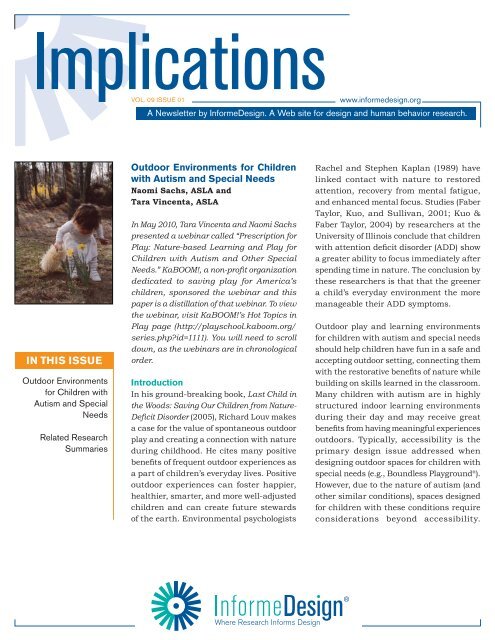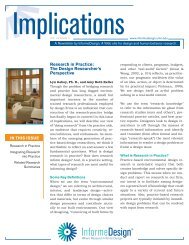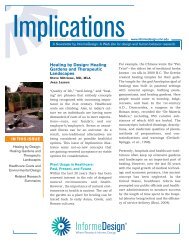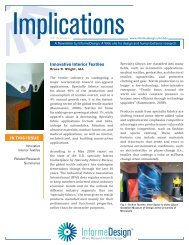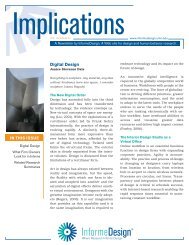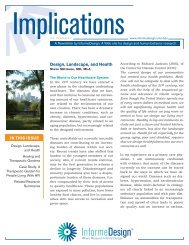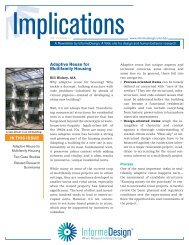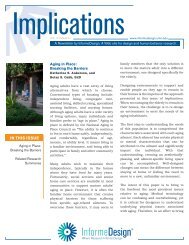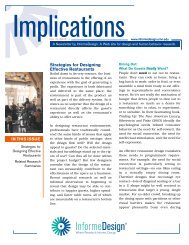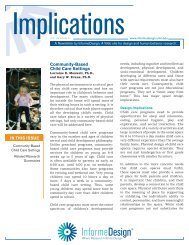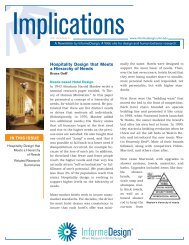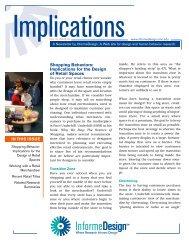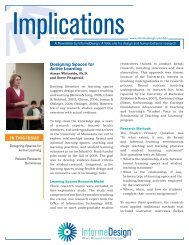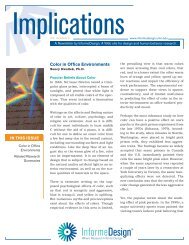Outdoor Environments for Children with Autism and ... - InformeDesign
Outdoor Environments for Children with Autism and ... - InformeDesign
Outdoor Environments for Children with Autism and ... - InformeDesign
Create successful ePaper yourself
Turn your PDF publications into a flip-book with our unique Google optimized e-Paper software.
Implications<br />
VOL. 09 ISSUE 01<br />
IN THIS ISSUE<br />
<strong>Outdoor</strong> <strong>Environments</strong><br />
<strong>for</strong> <strong>Children</strong> <strong>with</strong><br />
<strong>Autism</strong> <strong>and</strong> Special<br />
Needs<br />
Related Research<br />
Summaries<br />
www.in<strong>for</strong>medesign.org<br />
A Newsletter by In<strong>for</strong>meDesign. A Web site <strong>for</strong> design <strong>and</strong> human behavior research.<br />
<strong>Outdoor</strong> <strong>Environments</strong> <strong>for</strong> <strong>Children</strong><br />
<strong>with</strong> <strong>Autism</strong> <strong>and</strong> Special Needs<br />
Naomi Sachs, ASLA <strong>and</strong><br />
Tara Vincenta, ASLA<br />
In May 2010, Tara Vincenta <strong>and</strong> Naomi Sachs<br />
presented a webinar called “Prescription <strong>for</strong><br />
Play: Nature-based Learning <strong>and</strong> Play <strong>for</strong><br />
<strong>Children</strong> <strong>with</strong> <strong>Autism</strong> <strong>and</strong> Other Special<br />
Needs.” KaBOOM!, a non-profit organization<br />
dedicated to saving play <strong>for</strong> America’s<br />
children, sponsored the webinar <strong>and</strong> this<br />
paper is a distillation of that webinar. To view<br />
the webinar, visit KaBOOM!’s Hot Topics in<br />
Play page (http://playschool.kaboom.org/<br />
series.php?id=1111). You will need to scroll<br />
down, as the webinars are in chronological<br />
order.<br />
Introduction<br />
In his ground-breaking book, Last Child in<br />
the Woods: Saving Our <strong>Children</strong> from Nature-<br />
Deficit Disorder (2005), Richard Louv makes<br />
a case <strong>for</strong> the value of spontaneous outdoor<br />
play <strong>and</strong> creating a connection <strong>with</strong> nature<br />
during childhood. He cites many positive<br />
benefits of frequent outdoor experiences as<br />
a part of children’s everyday lives. Positive<br />
outdoor experiences can foster happier,<br />
healthier, smarter, <strong>and</strong> more well-adjusted<br />
children <strong>and</strong> can create future stewards<br />
of the earth. Environmental psychologists<br />
Rachel <strong>and</strong> Stephen Kaplan (1989) have<br />
linked contact <strong>with</strong> nature to restored<br />
attention, recovery from mental fatigue,<br />
<strong>and</strong> enhanced mental focus. Studies (Faber<br />
Taylor, Kuo, <strong>and</strong> Sullivan, 2001; Kuo &<br />
Faber Taylor, 2004) by researchers at the<br />
University of Illinois conclude that children<br />
<strong>with</strong> attention deficit disorder (ADD) show<br />
a greater ability to focus immediately after<br />
spending time in nature. The conclusion by<br />
these researchers is that that the greener<br />
a child’s everyday environment the more<br />
manageable their ADD symptoms.<br />
<strong>Outdoor</strong> play <strong>and</strong> learning environments<br />
<strong>for</strong> children <strong>with</strong> autism <strong>and</strong> special needs<br />
should help children have fun in a safe <strong>and</strong><br />
accepting outdoor setting, connecting them<br />
<strong>with</strong> the restorative benefits of nature while<br />
building on skills learned in the classroom.<br />
Many children <strong>with</strong> autism are in highly<br />
structured indoor learning environments<br />
during their day <strong>and</strong> may receive great<br />
benefits from having meaningful experiences<br />
outdoors. Typically, accessibility is the<br />
primary design issue addressed when<br />
designing outdoor spaces <strong>for</strong> children <strong>with</strong><br />
special needs (e.g., Boundless Playground ® ).<br />
However, due to the nature of autism (<strong>and</strong><br />
other similar conditions), spaces designed<br />
<strong>for</strong> children <strong>with</strong> these conditions require<br />
considerations beyond accessibility.
Implications www.in<strong>for</strong>medesign.org<br />
Knowledge <strong>and</strong> a comprehensive underst<strong>and</strong>ing of the<br />
challenges shared by these children push designers<br />
toward a more holistic view of outdoor spaces <strong>for</strong> all<br />
children. Nature-based learning <strong>and</strong> play spaces can<br />
become more universal <strong>and</strong> inclusive by addressing a<br />
variety of issues including sensory, cognitive, visual<br />
<strong>and</strong> auditory impairment, <strong>and</strong> limited fine <strong>and</strong> gross<br />
motor skills. This article explores research <strong>and</strong><br />
design considerations <strong>for</strong> creating outdoor, naturebased<br />
spaces that allow children <strong>with</strong> autism <strong>and</strong><br />
other special needs to play <strong>and</strong> learn at their own<br />
com<strong>for</strong>t level, overcoming common challenges in<br />
a safe, fun environment that is equally engaging<br />
<strong>for</strong> any child.<br />
What is <strong>Autism</strong>?<br />
<strong>Autism</strong>, or <strong>Autism</strong> Spectrum Disorder (ASD), is a<br />
neurological developmental disability that usually<br />
appears in the first three years of life <strong>and</strong> that<br />
especially impacts development in areas of social,<br />
verbal, <strong>and</strong> nonverbal communication. According<br />
to the Center <strong>for</strong> Disease Control <strong>and</strong> Prevention,<br />
ASD affects as many as 1 in 110 children (<strong>Autism</strong><br />
<strong>and</strong> Developmental Disabilities Monitoring Network<br />
Surveillance Year 2006 Principal Investigators, 2009)<br />
<strong>and</strong> is four times more prevalent in boys than in girls<br />
(<strong>Autism</strong> <strong>and</strong> Developmental Disabilities Monitoring<br />
Network Surveillance Year 2000 Principal Investigators,<br />
2002).<br />
<strong>Autism</strong> is considered a “broad spectrum disorder” in<br />
that it affects each individual differently <strong>and</strong> to varying<br />
degrees. People often say, “If you’ve met one person <strong>with</strong><br />
autism, you’ve met one person <strong>with</strong> autism,” meaning<br />
autism can manifest itself very differently from one<br />
individual to another. On one end of the spectrum,<br />
people <strong>with</strong> severe classical autism may be nonverbal,<br />
have significant cognitive challenges, be prone to social<br />
isolation, <strong>and</strong> engage in repetitive behaviors such as<br />
h<strong>and</strong>-flapping or rocking. On the other end of the<br />
spectrum, individuals <strong>with</strong> high functioning autism or<br />
Asperger’s syndrome may have good language skills,<br />
Where Research In<strong>for</strong>ms Design®<br />
Gardening activities are a great way to get kids familiar <strong>with</strong> the<br />
different textures <strong>and</strong> scents of plants in a controlled manner.<br />
above-average intelligence, <strong>and</strong> a keen interest in<br />
particular subjects.<br />
<strong>Autism</strong> affects the way children perceive <strong>and</strong> process<br />
their world. Though symptoms vary tremendously<br />
from person to person, the three main areas affected<br />
are social interaction <strong>and</strong> communication, sensory<br />
integration, <strong>and</strong> repetitive patterns of behavior.<br />
Social interaction <strong>and</strong> communication:<br />
Forty to fifty percent of children <strong>with</strong> autism are either<br />
completely nonverbal, or, at the very least, have trouble<br />
carrying on two-way conversations. They have trouble<br />
reading facial expressions or anticipating what someone<br />
else might be thinking or feeling. As a result, they have<br />
difficulty expressing their needs <strong>and</strong> are often solitary<br />
<strong>and</strong> detached.<br />
Sensory integration:<br />
Many children <strong>with</strong> autism also have some <strong>for</strong>m of<br />
Sensory Integration Dysfunction (SID), a condition<br />
shared by many other children <strong>with</strong> special needs.<br />
This includes a hypo- or hyper-sensitivity to sensory<br />
stimuli including sound, sight, smells, tastes, <strong>and</strong><br />
textures. For example, some children may be hypersensitive<br />
(over-sensitive) to the texture or feel of fabric<br />
on their skin, a pavement surface, or the grass beneath<br />
2
Implications www.in<strong>for</strong>medesign.org<br />
their feet. On the other end of the spectrum, children<br />
may be hypo-sensitive (under-sensitive) to pain <strong>and</strong><br />
unable to underst<strong>and</strong> how to protect themselves from<br />
physical injury.<br />
Another common sensory issue <strong>for</strong> persons <strong>with</strong> autism<br />
is the inability to filter input from external sources.<br />
They experience everything at once — visual stimuli,<br />
sounds, <strong>and</strong> smells, which can become overwhelming.<br />
This, coupled <strong>with</strong> communication <strong>and</strong> language<br />
challenges, can frequently lead to tantrums <strong>and</strong> “meltdowns.”<br />
Repetitive patterns of behavior:<br />
Restricted, repetitive, <strong>and</strong> stereotyped behaviors<br />
such as h<strong>and</strong>-flapping, rocking, or head-banging<br />
are common in children <strong>with</strong> autism. They may have<br />
a certain order or routine that must be followed in<br />
certain circumstances, or they may become fixated<br />
on organizing objects.<br />
Other common behaviors:<br />
Other manifestations include being more interested<br />
in objects than in other children, preferring to be<br />
alone <strong>and</strong> detached, resistance to change <strong>and</strong> an<br />
attachment or reliance on sameness, an inability to<br />
engage in make-believe play, a resistance to being<br />
touched or cuddled, <strong>and</strong> difficulty <strong>with</strong> fine <strong>and</strong> gross<br />
motor skills.<br />
Issues Shared <strong>with</strong> Other<br />
<strong>Children</strong> <strong>with</strong> Special Needs<br />
Many of these conditions, behaviors, or tendencies —<br />
particularly motor <strong>and</strong> neuromuscular challenges;<br />
cognitive, sensory, <strong>and</strong> communication issues; <strong>and</strong><br />
visual <strong>and</strong> auditory impairment — are shared <strong>with</strong><br />
a broader community of children <strong>with</strong> special needs,<br />
including those <strong>with</strong> Down syndrome, developmental<br />
delay, cerebral palsy, spina bifida, sensory disorders,<br />
<strong>and</strong> vision <strong>and</strong> auditory deficiencies. Some therapies<br />
<strong>and</strong> design interventions can help those <strong>with</strong> a range<br />
of special needs.<br />
Where Research In<strong>for</strong>ms Design®<br />
Common Therapies<br />
Common therapies, often carried out by family<br />
members, teachers, <strong>and</strong> therapists (occupational,<br />
physical, speech <strong>and</strong> language, <strong>and</strong> horticultural<br />
therapists), include:<br />
• Applied Behavior Analysis<br />
• Floor Time Pivotal Response Training<br />
• Occupational Therapy<br />
• Physical Therapy<br />
• Sensory Integration Therapy<br />
• Speech <strong>and</strong> Language Therapy<br />
• Treatment <strong>and</strong> Education of Autistic <strong>and</strong> Related<br />
Communication H<strong>and</strong>icapped <strong>Children</strong> (TEACCH)<br />
Additional in<strong>for</strong>mation about common therapies that<br />
are used to treat autism <strong>and</strong> how they are per<strong>for</strong>med<br />
can be found through a document linked at the<br />
end of this article. Important concepts from these<br />
therapies can be extrapolated into the design of outdoor<br />
environments.<br />
Research on the Role of Nature in<br />
Treating <strong>Children</strong> <strong>with</strong> <strong>Autism</strong><br />
Early intervention is one of the most important keys<br />
to improvement in autism symptoms – one reason<br />
why appropriate outdoor learning environments are<br />
crucial. All children learn <strong>and</strong> develop cognitively as<br />
well as physically through play, <strong>and</strong> a growing body<br />
of research points to the important role that nature<br />
plays in that development. Creating a supportive<br />
environment can go a long way in helping children<br />
<strong>with</strong> special needs (<strong>and</strong> their siblings) experience the<br />
world in a meaningful way.<br />
As <strong>with</strong> any population, the safest <strong>and</strong> most beneficial<br />
outdoor environments <strong>and</strong> programs <strong>for</strong> children<br />
should be based on research <strong>and</strong> evidence (i.e.,<br />
evidence-based design — EBD). Research directly<br />
examining the impact of natural play environments<br />
on children <strong>with</strong> autism or other special needs has<br />
been minimal. Currently, we must rely on the body of<br />
3
Implications www.in<strong>for</strong>medesign.org<br />
research <strong>and</strong> in<strong>for</strong>mation that does exist including (1)<br />
general in<strong>for</strong>mation about autism <strong>and</strong> related disorders<br />
(such as Sensory Integration Dysfunction); (2) firsth<strong>and</strong><br />
accounts from people <strong>with</strong> autism <strong>and</strong> their<br />
caregivers; (3) general in<strong>for</strong>mation <strong>and</strong> research on<br />
nature-based play <strong>and</strong> learning <strong>for</strong> all children; <strong>and</strong><br />
(4) st<strong>and</strong>ard guidelines <strong>for</strong> playgrounds, including<br />
the Americans <strong>with</strong> Disabilities Act, <strong>and</strong> other safety<br />
considerations.<br />
Post-occupancy evaluations (POEs) would be helpful<br />
in determining whether certain design strategies have<br />
the desired effect <strong>and</strong> how they can be applied to the<br />
broadest population. At this point, however, there is<br />
not enough research or funding to build specifically<br />
designed spaces, <strong>and</strong> thus we have very few spaces to<br />
measure whether a design is functioning according to<br />
a particular program. Even small-scale interventions,<br />
studied systematically, could provide useful in<strong>for</strong>mation<br />
that would in<strong>for</strong>m future design.<br />
Design Guidelines<br />
In creating outdoor environments <strong>for</strong><br />
children across the autism spectrum,<br />
design considerations must address a<br />
broad range of challenges experienced<br />
by this population. Because many of<br />
these challenges are shared by children<br />
<strong>with</strong> related disorders, the issues faced<br />
by a large population of children <strong>with</strong><br />
special needs can be accommodated<br />
<strong>with</strong> thoughtful, creative, inclusive<br />
design.<br />
One goal of these environments<br />
should be to help children apply the<br />
lessons they learn in the classroom to<br />
a real-world environment, providing<br />
them <strong>with</strong> coping skills outside of<br />
the classroom. However, heightened<br />
sensory issues are one of the most<br />
Where Research In<strong>for</strong>ms Design®<br />
common challenges <strong>for</strong> children <strong>with</strong> ASDs. It can be<br />
difficult <strong>for</strong> them to filter the amount of in<strong>for</strong>mation<br />
coming at them all at once in outdoor, public spaces.<br />
There<strong>for</strong>e, outdoor environments <strong>for</strong> this population<br />
should be both com<strong>for</strong>table <strong>and</strong> supportive as they<br />
encourage skill-building.<br />
Through examination of current available research,<br />
reference materials, literature, <strong>and</strong> personal interviews<br />
<strong>and</strong> observations, Tara Vincenta has developed the<br />
following guidelines <strong>for</strong> consideration when designing<br />
outdoor environments <strong>for</strong> children <strong>with</strong> ASDs. Many of<br />
these ideas can be creatively integrated into existing<br />
outdoor play spaces, retrofitting them to be more<br />
user friendly to children <strong>with</strong> ASDs. As <strong>with</strong> most<br />
design guidelines, these should be considered <strong>for</strong> their<br />
appropriateness <strong>with</strong>in the context of a given project <strong>and</strong><br />
should not be considered “guaranteed” solutions.<br />
Tara Vincenta has developed guidelines <strong>for</strong> consideration when designing outdoor<br />
environments <strong>for</strong> children <strong>with</strong> ASDs. This is a plan view of an outdoor environment designed<br />
using these guidelines; however, many of these guidelines can be creatively integrated into<br />
existing outdoor play spaces.<br />
4
Implications www.in<strong>for</strong>medesign.org<br />
• Select a location that is tranquil <strong>and</strong> quiet,<br />
<strong>with</strong> the least amount of distractions possible.<br />
Noise from air conditioning compressors, adjacent<br />
traffic, <strong>and</strong> high-pitched or humming noise can be<br />
overwhelming.<br />
• Include 5’-0” minimum height fencing that<br />
cannot be easily climbed to prevent children from<br />
straying outside the area’s boundaries, ensuring<br />
safety <strong>and</strong> security.<br />
•<br />
Provide smooth, wide pathways <strong>and</strong> surfaces<br />
to eliminate the feeling of crowding. In addition,<br />
smooth non-glare paving provides a proper surface<br />
<strong>for</strong> children <strong>with</strong> mobility issues <strong>and</strong> is important<br />
<strong>for</strong> children <strong>with</strong> ASDs, many of whom are sensitive<br />
to textures <strong>and</strong> bright light.<br />
• Provide a clear edge along pathways so that<br />
visually-impaired persons are aware of the edge<br />
of the path surface.<br />
•<br />
<strong>Outdoor</strong> environments <strong>for</strong> children <strong>with</strong> autism could include<br />
transitions between spaces/activities, orientation maps, <strong>and</strong><br />
elements of consistency.<br />
Avoid specifying materials, including toxic<br />
plants, that are easily ingested, as all children<br />
at some time explore their world through taste.<br />
• Provide orientation maps that illustrate a layout<br />
of the garden or play space so users know where<br />
they are <strong>and</strong> what to expect next. Surprises can<br />
create anxiety in persons <strong>with</strong> ASDs.<br />
Where Research In<strong>for</strong>ms Design®<br />
•<br />
•<br />
Provide plenty of shade, both <strong>with</strong> trees <strong>and</strong><br />
shade structures, as persons <strong>with</strong> ASDs are often<br />
photosensitive.<br />
Provide transitions between spaces/activities<br />
to allow individuals to orient themselves be<strong>for</strong>e<br />
experiencing something new. <strong>Children</strong> <strong>with</strong> ASDs<br />
are uncom<strong>for</strong>table <strong>with</strong> change, <strong>and</strong> providing<br />
space between different activities, accompanied<br />
by an orientation map, can help them anticipate<br />
these changes.<br />
• Include some elements of consistency such as<br />
a hedge, stone wall, or an element that creates a<br />
com<strong>for</strong>ting, predictable pattern.<br />
•<br />
Sequence activities to introduce elements <strong>and</strong><br />
ideas slowly <strong>and</strong> build upon skills <strong>and</strong> com<strong>for</strong>t<br />
levels.<br />
• Provide fixed <strong>and</strong> non-fixed elements –<br />
unpredictable or changeable elements such<br />
as furniture locations, <strong>for</strong> example, can be<br />
disconcerting <strong>for</strong> persons <strong>with</strong> ASDs. Create a<br />
sequence where the fixed element is experienced<br />
first <strong>for</strong> a sense of security, <strong>and</strong> further on, areas<br />
that are changeable to create a challenge that<br />
children have the opportunity to overcome.<br />
•<br />
Provide opportunities <strong>for</strong> increased socialization,<br />
such as gardening, that encourage one-on-one<br />
interaction.<br />
• Provide plenty of visual aids <strong>and</strong> signage as up<br />
to 50% of persons <strong>with</strong> ASD are nonverbal. Some<br />
children <strong>with</strong> autism use a picture exchange system<br />
(PICT) to aid their communication <strong>with</strong> family<br />
members <strong>and</strong> teachers. There<strong>for</strong>e, in designing<br />
outdoor environments, incorporating signage <strong>with</strong><br />
clear, simple pictures to communicate ideas or<br />
intended use of certain play <strong>and</strong> learning elements<br />
is an important consideration. Include Braille <strong>for</strong><br />
visually impaired persons <strong>and</strong> sign language skillbuilding<br />
to encourage communication between<br />
verbal <strong>and</strong> nonverbal children.<br />
5
Implications www.in<strong>for</strong>medesign.org<br />
•<br />
•<br />
Provide opportunities to overcome sensory<br />
issues, as many persons <strong>with</strong> ASDs have an overor<br />
under-responsive sensory system <strong>and</strong> react<br />
differently to sounds, textures, or visual stimuli.<br />
Gardening activities are a great way to get kids<br />
familiar <strong>with</strong> different textures <strong>and</strong> scents of plants<br />
in a controlled manner.<br />
Provide opportunities <strong>for</strong> exercise <strong>and</strong> <strong>for</strong><br />
increasing motor skills, coordination, <strong>and</strong><br />
balance. Beyond play structures, consider adding<br />
a walk challenge path or exercise loop. Gardening<br />
activities help to increase fine <strong>and</strong> gross motor<br />
skills, body awareness, <strong>and</strong> motion in addition to<br />
providing a calming connection to nature.<br />
• Provide soothing areas <strong>for</strong> the user to escape<br />
<strong>and</strong> re-center when overwhelmed, or to watch<br />
activities from a distance until com<strong>for</strong>table enough<br />
to participate —a bamboo tunnel, a low growing<br />
tree to hide beneath, or a fence panel <strong>with</strong> viewing<br />
holes.<br />
• Provide hammocks or hammock swings <strong>for</strong> a<br />
sense of com<strong>for</strong>t by being held tightly by something<br />
<strong>and</strong> to be soothed by the swinging motion.<br />
• Build in challenges to help generalize skills to a<br />
real-world environment. It is important to provide<br />
a level of com<strong>for</strong>t but also to encourage kids to<br />
overcome common fears. A simple example of this<br />
is to sequence a concept, such as transition areas,<br />
so they gradually become shorter, or gradually<br />
present more directional options <strong>for</strong> the user.<br />
Where Research In<strong>for</strong>ms Design®<br />
Soothing areas <strong>and</strong> orientation maps can be incorporated into<br />
outdoor spaces <strong>for</strong> children <strong>with</strong> autism <strong>and</strong> other special needs.<br />
Conclusion<br />
Creating thoughtful, engaging outdoor play <strong>and</strong><br />
learning environments that incorporate these design<br />
guidelines gives consideration to the less apparent<br />
challenges of a growing population of children on the<br />
autism spectrum. By connecting children <strong>with</strong> each<br />
other, nature, <strong>and</strong> the broader world, we give them an<br />
opportunity to have fun, <strong>and</strong> we provide some relief<br />
from rigid classroom <strong>and</strong> structured therapies in a safe<br />
<strong>and</strong> accepting environment that is engaging <strong>for</strong> all. As<br />
designers of outdoor spaces, it is vital <strong>for</strong> us to evolve<br />
play spaces beyond accessibility <strong>and</strong> actively integrate<br />
these additional concepts <strong>and</strong> ideas into our designs.<br />
With design based on research <strong>and</strong> existing evidence,<br />
we can create outdoor spaces that foster inclusive,<br />
nature-based, fun places <strong>for</strong> all children to enjoy. This<br />
can ultimately help children learn that, despite their<br />
different abilities, they have more in common <strong>with</strong> each<br />
other than they may have realized.<br />
6
Implications www.in<strong>for</strong>medesign.org<br />
References<br />
— <strong>Autism</strong> <strong>and</strong> Developmental Disabilities Monitoring<br />
Network Surveillance Year 2006 Principal<br />
Investigators. (2009, December 18). Prevalence<br />
of autism spectrum disorders --- autism <strong>and</strong><br />
developmental disabilities monitoring network,<br />
United States, 2006. Morbidity <strong>and</strong> Mortality Weekly<br />
Report Surveillance Summary, 58(SS10), 1-20.<br />
Retrieved April 19, 2011 from http://www.cdc.gov/<br />
mmwr/preview/mmwrhtml/ss5810a1.htm<br />
— <strong>Autism</strong> <strong>and</strong> Developmental Disabilities Monitoring<br />
Network Surveillance Year 2000 Principal<br />
Investigators. (2007, February 9). Prevalence<br />
of autism spectrum disorders --- autism <strong>and</strong><br />
developmental disabilities monitoring network,<br />
United States, 2000. Morbidity <strong>and</strong> Mortality<br />
Weekly Report Surveillance Summary, 56(SS01),1-<br />
11. Retrieved April 19, 2011 from http://www.cdc.<br />
gov/mmwr/preview/mmwrhtml/ss5601a1.htm<br />
— Faber Taylor, A., Kuo, F., & Sullivan, W. (2001).<br />
Coping <strong>with</strong> ADD: The surprising connection to<br />
green play settings. Environment <strong>and</strong> Behavior,<br />
33(1), 54-77.<br />
— Kaplan, R. <strong>and</strong> Kaplan, S. (1989). The experience<br />
of nature: A psychological perspective. Cambridge<br />
University Press, Cambridge, New York.<br />
— Kuo, G., & Faber Taylor, A. (2004). A potential<br />
natural treatment <strong>for</strong> attention-deficit/hyperactivity<br />
disorder: Evidence from a national study. American<br />
Journal of Public Health, 94(9), 1580-1586.<br />
— Louv, R. (2005). Last child in the woods: Saving our<br />
children from nature-deficit disorder. Chapel Hill,<br />
North Carolina: Algonquin Books of Chapel Hill.<br />
Recommended Reading<br />
On the web<br />
— SOL (Sequential <strong>Outdoor</strong> Learning) Environment<br />
http://www.solenvironment.org<br />
— Therapeutic L<strong>and</strong>scapes Network<br />
http://www.healingl<strong>and</strong>scapes.org, especially<br />
the Get Out <strong>and</strong> Play page (http://www.<br />
healingl<strong>and</strong>scapes.org/related-play.html)<br />
Where Research In<strong>for</strong>ms Design®<br />
— Tara <strong>and</strong> Naomi’s webinar, “Prescription <strong>for</strong> Play:<br />
Nature-based Learning <strong>and</strong> Play <strong>for</strong> <strong>Children</strong> <strong>with</strong><br />
<strong>Autism</strong> <strong>and</strong> Other Special Needs” on the KaBOOM!<br />
Website http://playschool.kaboom.org/series.<br />
php?id=1111<br />
—<br />
—<br />
The <strong>Children</strong> <strong>and</strong> Nature Network –<br />
http://www.children<strong>and</strong>nature.org<br />
Natural Learning Initiative -<br />
http://www.naturalearning.org<br />
In print<br />
— Hebert, B.B. (2003). Design guidelines of a<br />
therapeutic garden <strong>for</strong> autistic children. (Master<br />
Thesis, Louisiana State University). Available from<br />
http://etd.lsu.edu/docs/available/etd-0127103-<br />
211300/unrestricted/Hebert_thesis.pdf<br />
— Mostafa, M. (2008). An architecture <strong>for</strong> autism:<br />
Concepts of design intervention <strong>for</strong> the autistic<br />
user. International Journal of Architectural Research,<br />
2(1), 189-211.<br />
— Taylor, A.F., Kuo, F.E., & Sullivan, W.C. (2001).<br />
Coping <strong>with</strong> ADD: The surprising connection to<br />
green play settings. Environment <strong>and</strong> Behavior,<br />
33(1), 54-77.<br />
— Yuill, N., Strieth, S., Roake,C., Aspden, R., & Todd,<br />
B. (2007). Brief report: Designing a playground <strong>for</strong><br />
children <strong>with</strong> autistic spectrum disorders: Effects<br />
on playful peer interactions. Journal of <strong>Autism</strong><br />
Development Disorders, 37(6), 1192-1196. Available<br />
on Therapeutic L<strong>and</strong>scapes Network website: http://<br />
www.healingl<strong>and</strong>scapes.org/resources/reference-y.<br />
html<br />
For additional resources related to autism symptoms<br />
<strong>and</strong> therapies <strong>and</strong> the role of nature in children’s<br />
learning <strong>and</strong> development see the list of resources<br />
Naomi <strong>and</strong> Tara created at:<br />
http://www.healingl<strong>and</strong>scapes.org/blog/?p=2310<br />
7
Implications www.in<strong>for</strong>medesign.org<br />
About the Authors<br />
Naomi Sachs is founder <strong>and</strong><br />
director of the Therapeutic<br />
L<strong>and</strong>scapes Network (http://<br />
www.healingl<strong>and</strong>scapes.<br />
org), a knowledge base <strong>and</strong><br />
gathering space that provides<br />
in<strong>for</strong>mation, education, <strong>and</strong><br />
advocacy about gardens,<br />
l<strong>and</strong>scapes, <strong>and</strong> other green<br />
spaces that promote health <strong>and</strong> well-being. She is<br />
also principal at Naomi Sachs Design (http://www.<br />
naomisachsdesign.com), a design <strong>and</strong> consulting<br />
firm <strong>with</strong> a focus on gardens <strong>and</strong> other l<strong>and</strong>scapes<br />
that facilitate health <strong>and</strong> well-being. Naomi holds a<br />
Masters of L<strong>and</strong>scape Architecture from the University<br />
of Cali<strong>for</strong>nia, Berkeley. She has taught, written,<br />
<strong>and</strong> spoken about the restorative benefits of nature<br />
throughout the United States <strong>and</strong> abroad.<br />
Tara Vincenta, founder<br />
<strong>and</strong> principal of awardwinning<br />
Artemis L<strong>and</strong>scape<br />
Architects, Inc. (http://<br />
www.artemisLA.com), earned<br />
her bachelor’s degree in<br />
L<strong>and</strong>scape Architecture<br />
from the State University<br />
of New York’s College of<br />
Environmental Science <strong>and</strong> Forestry <strong>and</strong> a BS from<br />
Syracuse University. She also holds a Certificate of<br />
Merit in Healthcare Garden Design from the School of<br />
the Chicago Botanical Gardens. As a strong advocate <strong>for</strong><br />
the use of outdoor l<strong>and</strong>scapes <strong>for</strong> healing <strong>and</strong> education,<br />
Creator: Founding Sponsor:<br />
© 2002, 2005 by the Regents of the University of Minnesota.<br />
Tara has designed the award winning SOL Environment<br />
concept as a way of addressing the needs of over one<br />
million children <strong>with</strong> autism <strong>and</strong> their families.<br />
Related Research Summaries<br />
In<strong>for</strong>meDesign has many Research Summaries about<br />
designing environments <strong>for</strong> children <strong>with</strong> special<br />
needs <strong>and</strong> other related topics. This knowledge will<br />
be valuable to you as you consider your next design<br />
solution <strong>and</strong> is worth sharing <strong>with</strong> your clients <strong>and</strong><br />
collaborators.<br />
“Supportive Classrooms <strong>for</strong> <strong>Children</strong> <strong>with</strong> <strong>Autism</strong>”<br />
—International Journal of Architectural Research<br />
“Daycare Activity Areas Affect <strong>Children</strong>’s Play”<br />
—Environment <strong>and</strong> Behavior<br />
“Health Benefits of Including Nature Within<br />
Hospitals”<br />
—Journal of Environmental Psychology<br />
“Universal Design in <strong>Children</strong>’s Libraries”<br />
—<strong>Children</strong> <strong>and</strong> Libraries<br />
“Campuses that Support Students <strong>with</strong> Disabilities”<br />
—The Journal <strong>for</strong> Vocational Special Needs Education<br />
“Nature Improves Concentration <strong>for</strong> <strong>Children</strong> <strong>with</strong><br />
ADHD”<br />
—Journal of Attention Disorders<br />
Images Courtesy of<br />
Naomi Sachs, Naomi Sachs Design (p. 8, top)<br />
Tara Vincenta, Artemis L<strong>and</strong>scape Architects<br />
(remainder)<br />
The Mission<br />
The Mission of In<strong>for</strong>meDesign is to facilitate designers’<br />
use of current, research-based in<strong>for</strong>mation as a decisionmaking<br />
tool in the design process, thereby<br />
integrating research <strong>and</strong> practice.<br />
Published April 2011<br />
8


